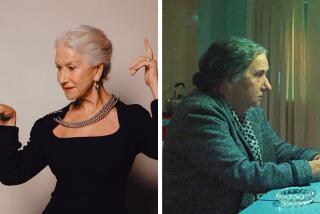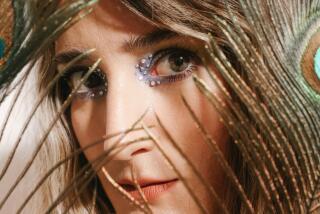Cathode Radiance : Computers Are Lighting the Way to an Utterly ‘80s Mode of Makeup and Hair-Color Selection
- Share via
The high-tech community cheered when computer graphics, which can create and alter images on a monitor, revolutionized the way information can be manipulated on bars and charts. The breakthrough also caught the imagination of beauty experts. If a few keystrokes could put colors on pie charts, they wondered, why not on faces?
The cosmetics industry already had computer-type devices to help in-store representatives match products to customers. What was needed was a way to preview--via computer image processing--a change in makeup or hair color.
In 1984, Elizabeth Arden introduced Elizabeth, its “makeover” computer. Then Shiseido and Intelligent Skincare (IS) brought out similar systems. In October, Clairol unveiled Color Visions, which allows a woman to see herself in a new hair color before taking the “Does she or doesn’t she?” plunge.
Most systems travel from store to store during national promotions. Elizabeth, for example, is scheduled to be at May Co., Montebello, Monday through Dec. 10; the IS Simulator will be at J. W. Robinson’s, Newport Beach, Tuesday through next Sunday. The systems capture a video image of a woman’s face and hair, digitize the picture, “remove” the makeup and hair color, and simulate new shades selected from a data base of the firm’s products. In Elizabeth’s case, a four-way split screen provides three different makeover images to compare to the original.
Once, these systems were too costly for all but the biggest beauty houses. But recently, for an investment of $375,000, a firm called Choyces introduced a program that analyzes and recommends colors and styles--but not brand names.
The system is the brainchild of former hairdresser Larry Steinhauer, who started offering computer services in his Fresno salon. He decided that if customers there were willing to pay up to $140 for it, others would respond. Choyces is being introduced at Saks Fifth Avenue, Beverly Hills, this week.
Clinique was the first line to feature a beauty “computer,” which is actually a question-and-answer board that operates more like an abacus, but the firm has no plans to go electronic. “Our computer continues to perform the service our dermatologists told us we needed to determine skin type,” says Carol Phillips, Clinique president. “I see no merit in trying to mechanize the consultation. Rigging up TV screens, the addition of magic buttons, electrifying the process is pure circus.”
Obviously, others in the industry disagree.
“Miniaturization of the components will eventually make computers available at the point of sale in any store,” says Gerald C. Beddall, president of Clairol’s consumer products division. He envisions a time when computers may replace Clairol’s toll-free help line. “Once we have the equipment to allow two people to hear and see each other, the consumer at home could contact a Clairol specialist on the computer for a face-to-face consultation,” he says.
The late research scientist Tom Cook, who worked for Elizabeth Arden labs in Indianapolis, where Elizabeth was built, agreed that in-store computers are only the beginning.
“I foresee devices in the home that will allow you to dial the department-store computer, which will have your image on file,” he said. “It will show how you look in certain makeup. It will know your perfume preferences and recommend new variations.”
And will scientists someday be able to digitize scent, so we can punch some keys and smell the newest perfume? Perhaps the idea isn’t so farfetched.
More to Read
Inside the business of entertainment
The Wide Shot brings you news, analysis and insights on everything from streaming wars to production — and what it all means for the future.
You may occasionally receive promotional content from the Los Angeles Times.










